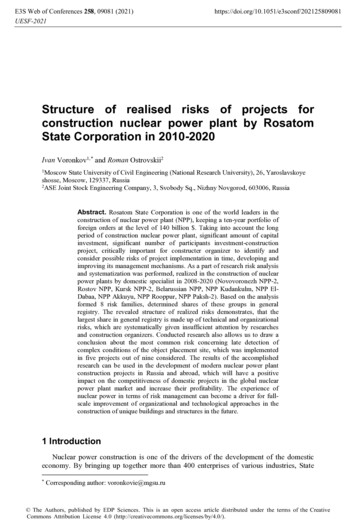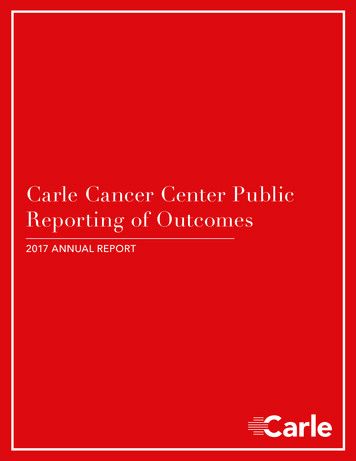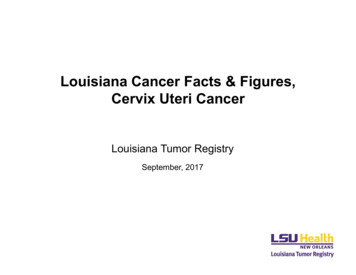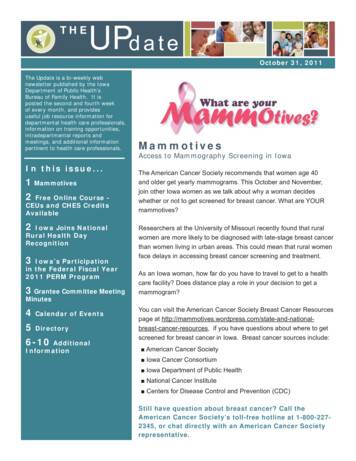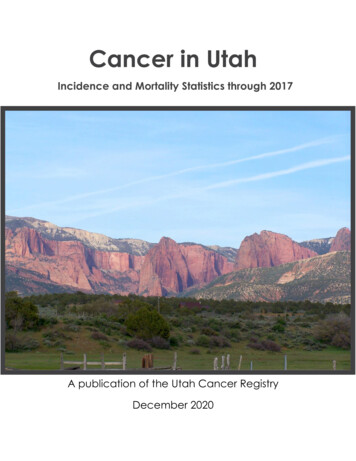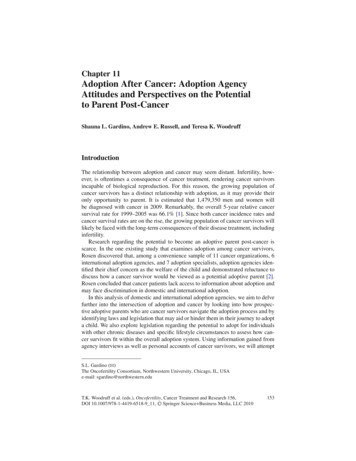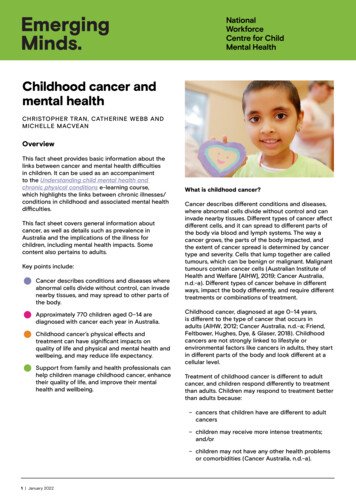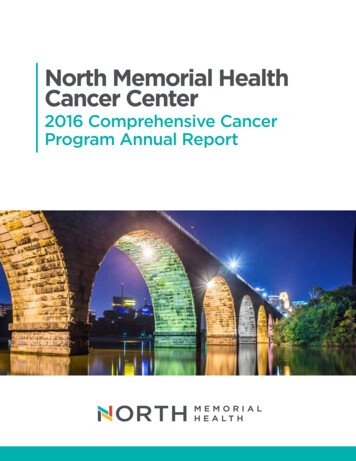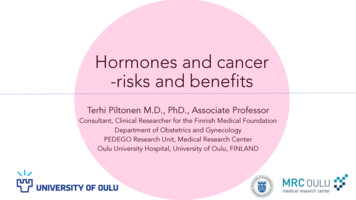
Transcription
Hormones and cancer-risks and benefitsTerhi Piltonen M.D., PhD., Associate ProfessorConsultant, Clinical Researcher for the Finnish Medical FoundationDepartment of Obstetrics and GynecologyPEDEGO Research Unit, Medical Research CenterOulu University Hospital, University of Oulu, FINLAND
Hormones have several benefits ContraceptionEnables amenorrhea and cycle controlImprove skin healthReduce hirsutismOvulation induction and endometrial preparation for embryoimplantationPrevent ovarian cystsImprove heavy bleeding and menstrual disturbancesReduce menopausal symptomsImprove metabolic profile in women with diminished ovarian reserve
Why would hormones cause cancer? If they are administrated wrong time (too late in menopause, fortoo long) If they are administered in a certain way (estrogen withoutprogestins, combination therapy or high exposure) If there is disadvantageous profile in the hormone receptorexpression or in the hormone metbolism
Gynecological cancers and hormonesCANCERBREAST CAENDOMETRIAL CAOVARIAN CACERVICAL CAINCIDENCE/year125/100 00025/100 00012/100 0007/100 00012%2.8%1.3%0.6%Lifetime riskASSOCIATIONTO HORMONES NulliparousLate first birthEarly menarcheBreast feedingAnovulatory stateHRTGeneticpredisposition Unopposed E2exposure(anovulation orHRT) Obesity (E2 fromfat tissue) Early menarche OCP use Late menopause HPV ( Hormonalsmoking)treatments (OI, HRT)are the Geneticmajorpredispositioncontributors
Gynecological cancers and hormonesCANCERBREAST CAENDOMETRIAL CAOVARIAN CACERVICAL CAINCIDENCE/year125/100 00025/100 00012/100 0007/100 00012%2.8%1.3%0.6%Lifetime riskNulliparousLate first birthEarly menarcheBreast feedingAnovulatory stateHRTGeneticpredispositionASSOCIATIONTO HORMONES HORMONESHAVEPROTECTIVEROLE yes Unopposed E2exposure(anovulation orHRT) Obesity (E2 fromfat tissue) Early menarche OCP use Late menopause HPV ( Hormonalsmoking)treatments (OI, HRT)are the Geneticmajorpredispositioncontributors yes yes No
Hormonal treatments and cancer
Contraceptives and cancer risk Combined contraceptives slightly increased breast cancer risk (OR, 1.08; CI, 1.00-1.17)Gierisch JM et al., 2013 Increased risk for cervical cancer (ever/current) HR 1.6 (1.1–2.2)-2.2(1.3–4.0)Roura et al., 2016, PlosOne (EPIC Cohort) Progestin only contraceptives “Progestins only” do not seem to increase cancer risk although data islimitedSamson et al., Breast Cancer Res Treat 2016 Increased breast cancer risk with 52mg levonorgestrel IUD?Soini et al., Acta Oncol 2016, Lyytinen et al. Int J Cancer 2010
HRT and cancer riskCANCERRISKBreastCombination HRT doublesthe riskEndometrium10-40% increased risk(higher risk with sequentialtherapy)Ovarian20-40% increased risk(both sequential andcontinuous therapy)Cervical?No risk? Reduced risk?Marjoribanks et al., Cochrane review 2017, Sjögren et al.,Maturitas 2016, Shi et al., Menopause 2016,
Cancers and mechanisms?
Breast cancer
Breast cancer Up to 70-80% of all breast cancers express the ER-α Proliferation and suppression of antiproliferative and apoptotictargets Postmenopausal women with estrogen or androgen levels inthe highest upper quartile have 2-3x risk for breast cancer(Kaaks et al., 2005; Missmer et al., 2004) Controversies à ER- cancers more common during fertile lifeand ER after menopause Correlation between serum hormone levels and tissue? Conflicting data
Estrogen receptors ERa Signaling through ERa results into proliferationand survival signals while suppressing theexpression of antiproliferative and apoptotictargets ERb ERβ has growth inhibitory properties and byforming heterodimers it can bind to ERareducing its transcription potential
PATHWAYEstrogen Metabolism PathwayEstrogen metabolitesOverviewRelated PathwaysEstrogen metabolism in the liver. produced through 2-, 4- and 16αhydroxylation pathways have differential estrogenic and genotoxicactivities 4- and 16α-hydroxylation pathways may havehigher estrogenic activity than estradiol 2-catechol estrogen metabolites may act aseither weak mitogens or inhibitors ofproliferationàIndividual metabolic profile might matterComponentsDownloads
HRT and breast ca risk Estrogen only HRT reduced the risk of breast cancer after 7 years’ use: 25/1000 à15-25/1000 WHI study and Million woman study Marjoribanks et al., Cochrane review 2017 Combination therapy continuously Increase in breast cancer after 5.6 years’ use: 19/1000 à 20-30/1000) WHI study and Million woman study Marjoribanks et al., Cochrane review 2017 2016 IMS recommendations: “the increased risk of breast cancer thus seems primarily, but not exclusively,associated with the use of a progestin with oestrogen therapy in women withouthysterectomy and may be related to duration of use” Data is not applicable for younger women ( 50 yrs)
Progestins and breast cancer Combining progestin to HRT for endometrial protection Isoform ratio (PRa/PRb) associates with prognosis (Mote et al., 2002) Progestins increase the risk of more aggressive ER / PR breast cancersin postmenopausal women (already existing tumors?) (Horwitz et al., 2008) Increase proliferation and increases invasiveness (Kariagina et la 2013) Alter stem cell development (Narod et al. 2010)
Breast cancer and stem cells (CSCs) Breast tissue progenitor cells effected by estrogenand progestins (and progesterone!)àCould explain the age-related difference betweenER- and ER cancer types CD44 CD24 More common in triple negative breast cancers Primed with estrogen Progestins expands the stem cell pool capable oftransforming into ER /PR cancer cellsFinlay-Schultz and Sartorius 2016
Androgens and breast cancer Androgens act through AR and commonly co-expresses with ER Some progestins can also act through AR 60-80% express the AR, which has been shown to have tissue protective effects inER breast cancer (Hillborn and Jansson 2017) Have antiproliferative effects on breast tissue Controversial results on the effects on hormone negative breast cancers (Hillborn andJansson 2017) No increase in breast cancer risk in women with PCOS(Chittenden et al., 2009) Future studies are warranted to investigate the role of AR in breast ca
Endometrial cancer
Endometrial cancer Endometrium beholds vast amountof ERs ERa/Erb ratio matters Progestreone/progestins majorrescue effect targets ERdownregulation In postmenopausal women majorstress for endometrium is unopposedestrogen effectà (Complex) Hyperplasiaà Endometrial cancer Hyperinlulinemia and inflammatoryfactors promote cancer progressionPiltonen T., PCOS: Endometrial markers, 2016
Fat tissue derived factors and endometrial cancerBMI-related endometrial cancer risk76543210 18.518.5- 2525- 3030- 35Modified from Rota et al, BJOG 2015 35
What is the sufficient E2/P4 combination to preventendometrial cancer but still maintain estrogenic benefits? E2 administration with minimal P4 exposure for the breast? Do we need cycles every month for endometrial protection? IUD progestins Is there a increased risk for breast cancer with Mirena? More studies needed with adequate adjustments 13.5mg depot IUD instead of 52mg?Soini et al., Acta Oncol 2016, Lyytinen et al. Int J Cancer 2010 Micronized progesterone (mP4)?(Fournier et al., 2008)Breast cancer risk Does seem to result into adequate endometrialprotection (Pepi trial JAMA 1996)Fournier et al., In J Cancer 2005
Ovarian cancer
Ovarian cancer Estrogen promotes cancer progression in ovarian surface epithelium (Shuk-Mei Ho 2003) The risk is increased along HRT and the usage time Associates especially with serous CA (Shi et al., 2016) Both sequential and continuous increases the risk (RR) (Shi et al., 2016) ET only ET P ET à ET P1.37, CI: 1.19 to 1.58, P 0.0011.27, 95% CI: 1.18 to 1.36, P 0.0011.55, 95% CI: 1.05 to 2.30, P 0.027 Strong genetic component (Lynch, BRCA) Increased cancer risk in women with endometriosis Slightly increased ovarian cancer in women with PCOS
Cervical cancer
Cervical cancer Combine contraceptives: CC-related risk CIN3/CIS and ICC (HR 1.6 and HR 1.8 respectively for 15 years versusnever use) Hormone receptors, mainly progesterone, present in cervical tissue and influence the naturalhistory of HPV infection Sex steroid hormones enhance the expression of HPV 16 E6 and E7 oncogenes stimulate the degradation of p53 tumor suppressor genes enhance the ability of the viral DNA to transform cells carcinogenesis inductionRoura et al., Plosone 2016, EPIC Cohort The risk reduction occurs after cessation of the contraception HRT No correlation between hormone replacement therapy and cervical cancer (Gaducci et al., Gyn Endo2011 ) Ever use was associated with a reduced risk of ICC (HR 0.5, 95%CI: 0.4-0.8) Roura et al., Plosone2016, EPIC Cohort
Hormones and benefits related to cancer
Contraceptives and decreased cancer risk Combined contraceptives Decreased ovarian cancer risk (0.67; CI 0.50-0.89) Decreased endometrial cancer risk (0.66; CI 0.48-0.89) Both risk reduction lasts for several years/decadesIversen et al., 2017 Progestins only Decreased risk of breast cancer mortality (HR: 0.07; CI: 0.01-0.52)?Samson et al., Maturitas 2017 Hormonal IUD and decreased endometrial cancer risk
HRT and decreased cancer risk Does estrogen only treatment have beneficial effect on breasttissue? Et only HRT reduced the risk of breast cancer? after 7 years’ use: 25/1000 à15-25/1000 Mechanism? Through metabolic benefits?(WHI study and Million woman study, Marjoribanks et al., Cochrane review 2017 Adding progestin to HRT decreases endometrial cancer risk ER knockdown What about progesterone resistance (women with PCOS and endometriosis)? PCOS yes Endometriosis no? (Poole et al., Can Caus Cont 2017)
Colon VICALINCIDENCE/year125/100 00040/100 00025/100 00012/100 0007/100 000Lifetime risk12%4.3%2.8%1.3%0.6%In world statistics incidence per 100 000 women:1. Norway35.82. Denmark35.73. The Netherlands33.94. New Zeland33.55. Korea33.36. Australia32.0Morbidity and mortality are higher in men.Ferlay J, et al., GLOBOCAN 2012 v1.1, Cancer Incidence andMortality Worldwide: IARC CancerBase No. 11 [Internet]. Lyon,France: International Agency for Research on Cancer; 2014. Availablefrom: http://globocan.iarc.fr, accessed on 16/01/2015.
Colorectal cancer Combined contraceptives have been shown to decrease colorectal cancer risk (OR,0.86; CI, 0.79-0.95)Iversen et al., 2017; Gierisch JM et al., 2013 Several mechanism where estrogen protects from colorectal cancer (Luo et al.,Int J Surg, 2016) Bile acid synthesis Decrease in IGF-1 ERb activation has tumor restricting effects Conflicting data on HRT effects Marjoribanks et al., Cochrane review 2017 Luo et al.,Int J Surg, 2016 Bilateral oophorectomy 36% increase in risk Unilateral oophorectomy, 20% increased risk Hysterectomy 20% increased risk (limited data)Luo et al.,Int J Surg, 2016
Optimizing treatment?
Rescuing effect and optimizing treatmentCANCERBREAST CARESQUINGEFFECT OFHORMONES ?How to optimizebenefits and Aim E2 only ifpossibleAs low HRT dose aspossible and shorttreatment periodLow doseprogesterone,enough to maintainendometrial healthProgesterone/vsprogestin?Low dose IUD?Lifestylemodifications!ENDOMETRIAL CA Progesteronepromoting ERdownregulation Add P4 to HRT inwomen with intactuteriContinuous use ifhigh risk (obese,insulin resistantwomen?)IUD?Lifestylemodifications!OVARIAN CA Anovulation withOCP As low HRT dose aspossible and shorttreatment periodLifestyle modifications!CERVICAL CA NONEScreen HPVfor riskpopulations IUD option? Lifestylemodifications!
Conclusions Steroid hormones are commonly used to treat several conditionsand are an important part of female health management Steroid hormones play a role in breast, endometrial, ovarian andcervical cancer formation, but hormones also decrease theincidence of these cancers The mechanisms behind hormone-induced cancers are multifacetedand tightly linked also with other factors like inflammation/infection,life style/environmental factors and genetic predisposition
Conclusions Before starting hormonal treatments women should be informedabout the adverse effects but also about the large number ofbenefits they bring Gynecological cancer incidence is low (except for breast cancer)thus women with need for effective contraception or HRT shouldbe encourage to use these treatments Health care personnel and societies in general should targetthey efforts on preventive work, cancer screening and earlydiagnosis Scientific work should be carry out to improve HRT guidelinesand develop safer and more tissue-targeted hormonalmedications
Thank you.
Oulu University Hospital,University of Oulu, FINLAND. Hormones have several benefits Contraception . "Progestinsonly" do not seem to increase cancer risk although data is limited Samson et al., Breast CancerRes Treat 2016 . (Shuk-Mei Ho 2003) The risk is increasedalongHRT and theusagetime Associates especiallywithserousCA .
